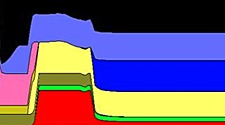
CABARET (Cement And Bentonite Alteration due to REactive Transport) is a GUI-driven software package developed by Quintessa for simulating reactions between cementitious materials and bentonite in multiple dimensions.
.png) CABARET allows users to specify cement-bentonite-rock-water systems flexibly, in terms of the chemical components present, the physical geometry of the simulated system and the processes to be represented. Chemical and transport processes can be fully coupled to one another so that, for example, porosity changes due to mineral precipitation and dissolution are coupled directly to the transport and flow processes.
CABARET allows users to specify cement-bentonite-rock-water systems flexibly, in terms of the chemical components present, the physical geometry of the simulated system and the processes to be represented. Chemical and transport processes can be fully coupled to one another so that, for example, porosity changes due to mineral precipitation and dissolution are coupled directly to the transport and flow processes.
Key parameters (effective diffusion coefficients, dispersion lengths, temperatures, reaction rates, hydraulic conductivities and flow boundary conditions) can be specified by value or as functions of one another to represent couplings between the parameters of the system. For example:
- diffusion coefficients can be expressed as functions of porosity and temperature;
- kinetic reaction rates can be entered as a function of temperature, mineral saturation, pH, carbonate concentrations and any other relevant derived quantity; and
- solid-solution reactions can be expressed in terms of the saturation states of the end-members of the reaction.
New user-defined derived quantities can also be introduced to the system and can be used to parameterise any inputs. For example a user-defined viscosity parameter could be introduced and written as a function of temperature. The newly-defined parameter could subsequently be used to parameterise the diffusion coefficient input.
Different properties and couplings can be applied to different media. For example, the procedure that calculates the hydraulic conductivity of cement as a function of porosity need not be the same as the function that calculates the hydraulic conductivity of bentonite as a function of porosity.
CABARET can import thermodynamic databases in Geochemist’s Workbench™ (Bethke, 2008) format, allowing a wide range of industry-standard databases to be used without modification.
CABARET uses an adaptive time-stepper to maximise solver efficiency, by reducing time-step sizes in response to external events (e.g. time-dependent inputs) or ‘emergent events’ (e.g. at the onset of precipitation of new minerals or complete dissolution of pre-existing minerals) and increasing time-step sizes when the system is undergoing more ‘smooth’ periods of evolution.

The image shows the CABARET GUI with inputs specifying solid media to be simulated and buttons for activating other windows (left) and panes (top) via which inputs can be specified and / or outputs controlled. The inset shows output for a simulation of bentonite interacting with cement porefluid; the cement-bentonite interface is at 0 m in the plot, the remainder of which shows volume fractions of minerals developed in the bentonite.
Bethke, CM (2008) Geochemical and Biogeochemical Reaction Modeling. Cambridge University Press.